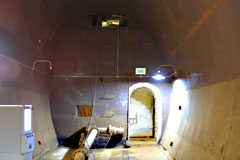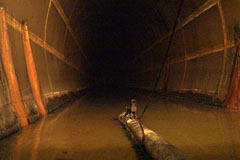 | |
WW2 Oil Storage Tunnels | |
|
In 1924 eleven above ground oil storage tanks were
built on and around Stokes Hill, from which Stokes Hill Wharf takes it's
name. The WW2 Japanese air raids in early 1942 destroyed 7 of the 11 tanks
and in November 1942 the decision was made to build eight underground
storage tanks to provide secure fuel
supplies. The tanks were constructed in secret by tunnelling back into
the escapment near the wharf and going underneath the city. The tunnels
were excavated entirely by hand, using picks and shovels with the aid of hand
held pneumatic tools, then the steel tanks were welded up and backfilled
with concrete.
Construction started in March 1943 at an estimated cost of 220,000 pounds and soon had 400 Civil Construction Corps workers raising a serious sweat. The money flowed out much like the sweat and it wasn't long before the cost increased to 850,000 pounds and eventually reached 1,087,808 pounds. Despite the feverish pace of construction, the war was long over before any of the tanks were ready and none of them were ever used for the intended purpose. There are four entrance tunnels with associated pipework and air ducts although nowadays access is restricted to the entry used for tours into tunnels 5 and 6. WALK MAP 38 These are the only two tunnels ever used, about ten years after the war, and you can still smell and see the kerosine leaking back out of the ground. Print a copy of the Walk Map on our Location Page to help you find your way. Many thanks to Rob and Karen Marchant from the Tour Tub, who also run the tunnel tours, for providing a lot of the information on this page. |  |



| |